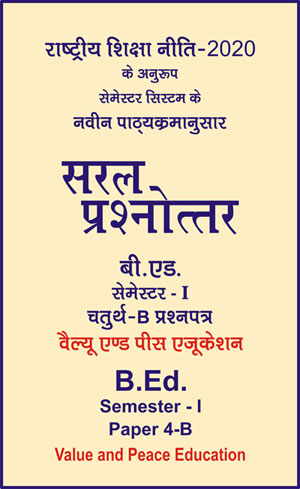|
बी एड - एम एड >> बी.एड. सेमेस्टर-1 प्रश्नपत्र-IV-B - वैल्यू एण्ड पीस एजुकेशन बी.एड. सेमेस्टर-1 प्रश्नपत्र-IV-B - वैल्यू एण्ड पीस एजुकेशनसरल प्रश्नोत्तर समूह
|
5 पाठक हैं |
||||||
बी.एड. सेमेस्टर-1 प्रश्नपत्र-IV-B - वैल्यू एण्ड पीस एजुकेशन (अंग्रेजी भाषा में)
Chapter 8 - Relevance of World Peace: First World War and Second World War and Relevance of United Nations Organization (U.N.O.)
Question- Explain the concept of World Peace in India Perspective.
Answer -
Indian society is plural and heterogeneous with an underlying current of unity, which is unparalleled in the world. Equal respect for all religions (Sarva Dharma Sambhav) and world as a family (Vasudhaiva Kutumbakam) was India’s message to the world at a time when most of the world civilizations were in their infancy, and it continues to be its message even today.
An extensive network of research institutes, foundations and programs maintains an active focus on all matters to do with peace, values and education. While some are university-based and take a secular focus, others are sponsored by religious and political organisations. A review of their publications suggests that peace education in India has at least three interrelated strands.
Textual and linguistic analysis: Many researchers have explored the diverse religious traditions and writings of India, reviewing their relevance for the teaching of peace. Ancient religious texts have been a particularly rich source of data. Linked with this has been linguistic analysis of key concepts. Kunnunkal (2001), for example, reviews the significance of Dharma, a central concept in Indian and especially Hindu thought. He notes that the root meaning is “to hold together, to unite, to integrate or bond”, suggesting that ‘unity in diversity” is at the heart of Dharma. He then goes on to explore ways of promoting a deeper understanding and application of Dharma in everyday life, and the role of education in facilitating this. Dharma Bharathi, the National Institute of Peace and Values Education in Andhra Pradesh, under the leadership of its President and Director, Professor M. Abel, likewise has developed new ways to teach peace using a multicultural and pluralistic approach based on its research into “the values embedded in the cultural and spiritual heritage of India” (Abel, 2001). The Institute advocates the teaching of meditation techniques, beginning with “one of the oldest and simplest spiritual exercises of India”, that of Namajapa, and going on to Shanti Yagna, a form of meditation that promotes reconciliation and peace in one’s own life (Abel, 2001). This emphasis on “peace within” is seen to help the development of “inner power” and “a reflective and peace-loving nature” (Abel, 2001).
Historical analysis: A second strand of research is based on analysis of the life, work and teachings of Mahatma Gandhi, and of other Indian prophets and gurus, and their relevance to peace education. The Centre for Gandhian Studies and Peace Research at the University of Delhi plays a key role here. Rajput and Walia (2001) refer to the impact of the Gandhian school of thought on education in India: “Its comprehensive approach was built upon an understanding of Indian ethos, culture and traditions, and an appreciation for its diversity, plurality and inherent trend to unity.” At the core of the Gandhian approach to peace education is the concept of non-violence, not just as a personal but as a social virtue where “society is largely regulated by the expression of non-violence in its mutual dealings” (Bose, 1994). Pandey (1999) offers a systematic analysis of the role of peace education in the National Curriculum Framework (NCF) for primary and secondary schools developed by the National Council for Educational Research and Training (NCERT) in 1988. She notes:
“Indian history is replete with examples of apostles of peace, harmony, human rights, universal brotherhood and understanding. Mahatma Gandhi even sacrificed his life for the cause of tolerance, peace and non-violence” (Pandey, 1999).
It is clear from her subsequent analysis that Gandhian thought has had a profound influence on the NCF, and on the later development of a curriculum framework for teacher education.
Political Analysis: A third key avenue of research is analysis of the political foundations of modern India, beginning with a study of its Constitution of 1950. Rajput and Walia (2001), in a particularly cogent analysis, explore the implications of the Constitution of India for peace education and more broadly for values education in contemporary India, concluding that the role of the teacher is critical:
“In order for them to be the transmitters of social cohesion and harmony, their role has to be reformulated and effectively internalized so they can inculcate faith in democratic procedures and in the values of justice, liberty and freedom” (Rajput & Walia, 2001).
Building on an analysis of the Constitution of India, Pandey (1999) goes on to research the National Policies on Education (NPE) of 1968 and 1986, and their advocacy of peace education.
India has always worked for peace and understanding between nations, treating the whole world as one family. True to this tradition, education has to strengthen this worldview and motivate the younger generations for international cooperation and peaceful coexistence.
Pandey draws on her analyses to trace the impact of the Constitution of India and the National Policies on Education, on the NCF of 1988 and the later curriculum framework for teacher education, noting the extent to which peace education and value education are integrated into the fabric of the various curricula and the textbooks developed from them.
|
|||||













